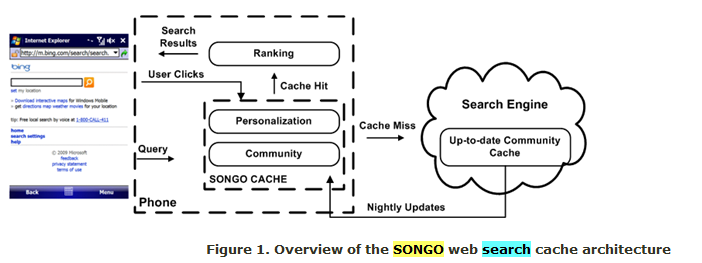Microsoft mobile search cache enables 'search on the go' (SONGO)

Digging for more TechFest 2010 info has given me reason to comb the always-interesting Microsoft Research site. My latest find (which the company may or may not show off at this week's TechFest 2010 research showcase) is a research project known as Microsoft SONGO (Search on the Go).
Microsoft has expunged most of the SONGO references from the Microsoft Research (MSR) site and many from Google. But not from Bing.
Update (March 3): Microsoft has made the SONGO page live on the Microsoft Research site and is showing off the technology at TechFest this week.
SONGO is "a mobile search and advertisement cache architecture for mobile devices," according to the cached Bing site. SONGO allows most user-submitted queries to be served locally without having to use the 3G link.
More information from a white paper synopsis about SONGO that is still on the MSR site:
"Initially, a community-based search cache is generated by mining the most popular queries and links from the mobile search logs. This cache is updated daily making sure that the latest popular information is always available locally on the mobile device. Over time, the community-based cache is incrementally updated with the queries and links that the individual user submits and visits respectively. An analysis of 200 million queries shows that, on average, 66% of the search queries submitted by an individual user can be locally served by caching 2,500 links at the expense of 1MB of flash and 200KB of RAM space. A prototype implementation of SONGO in Windows Mobile demonstrates that a cache hit results into 16x faster responses and 23x energy savings when compared to querying through the 3G link."
(The "Windows Mobile" reference in the description above leads me to wonder whether SONGO is in limbo, like Windows Mobile 6.x, or whether Microsoft simply hasn't yet updated its naming conventions on its Research site to include "Windows Phone Series" and "Windows Phone OS.")
Here's the cached architectural diagram of SONGO from the cached Bing site. (Click on the diagram to enlarge):
SONGO allows user to search and access personal files, search results, local business information, ads, and other information across all of their devices -- phones, PCs and the cloud -- from their phones, according to the information I found via Bing.
"Our efforts on the SONGO project has focused on mobile search and avertisements. We have designed and implemented two prototype applications that demonstrate how the SONGO architecture can be used to instantly provide search results and advertisements for both web and local search," according to the cached site. The two protoype apps include one FaceBook real-time-search one, and another "Quick Ads" demo app which shows off real-time business look-ups.
TechFest 2010 is this year's version of Microsoft Research annual show-and-tell event where Microsoft employees can check out new technologies under development by Microsoft's research arm. In many ways, the event is a matchmaking one, via which product teams can get early access to research technologies and get them into the commercialization pipeline.
In previous years, Microsoft has allowed press limited access to TechFest events. This year, Microsoft allowed certain press (I'm not among them) to get prebriefings on certain MSR technologies prior to opening the doors to Microsoft employees.
